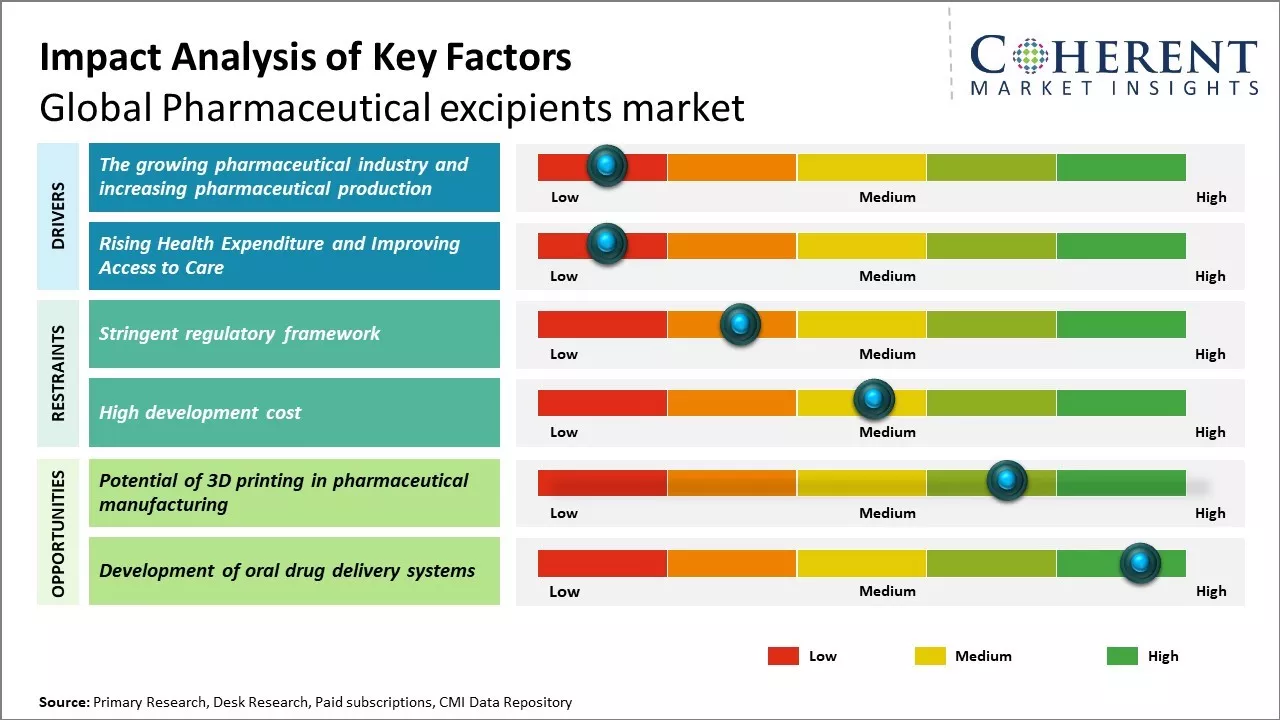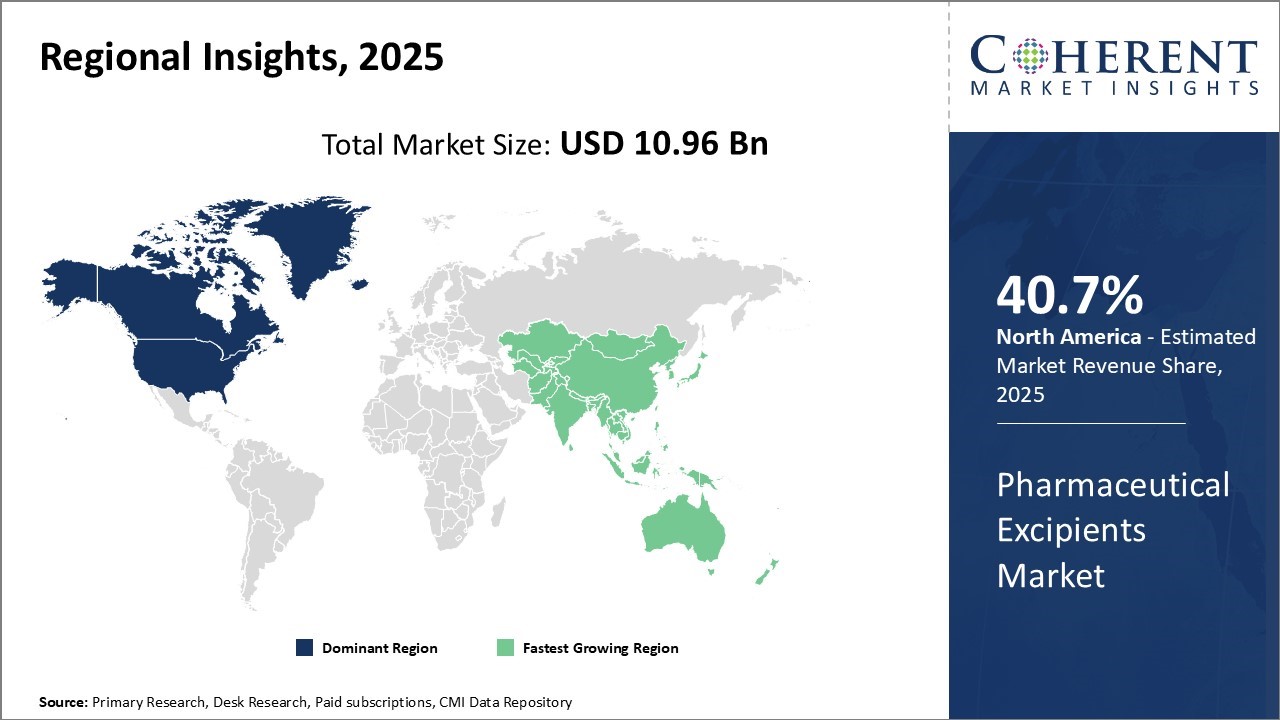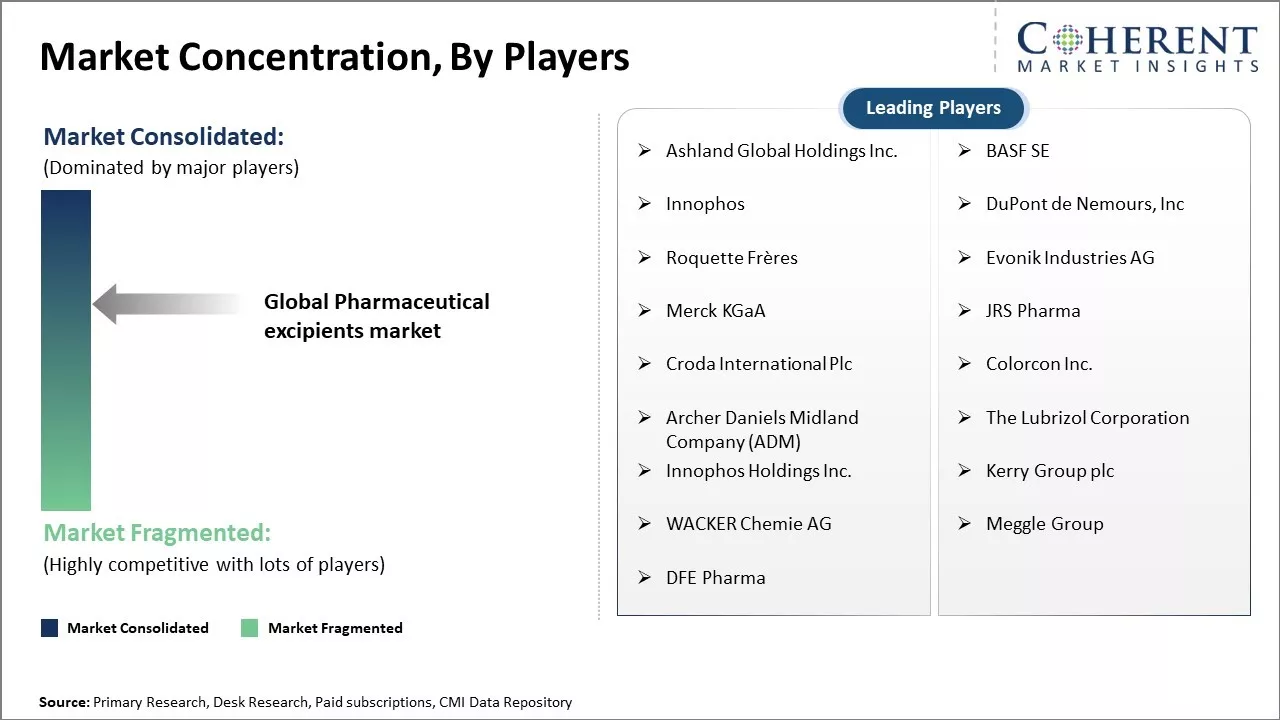Global pharmaceutical excipients market is estimated to be valued at USD 10.96 Bn in 2025 and is expected to reach USD 19.29 Bn by 2032, exhibiting a compound annual growth rate (CAGR) of 8.4% from 2025 to 2032.

To learn more about this report, Download Free Sample
The pharmaceutical excipients market is witnessing steady growth, driven by the increasing complexity of drug formulations and rising demand for innovative drug delivery systems. Excipients, though pharmacologically inactive, play a crucial role in enhancing the stability, bioavailability, and manufacturability of pharmaceutical products. With the growing focus on patient-centric formulations such as orally disintegrating tablets, controlled-release drugs, and pediatric/geriatric-friendly dosage forms, the pharmaceutical excipients market demand has surged.
Additionally, advances in biologics and novel therapies have created a need for specialized excipients that can ensure product stability and compatibility. The market is also benefiting from the increasing use of inorganic excipients like calcium phosphates, magnesium stearate, and silicon dioxide in solid and semi-solid dosage forms. Furthermore, regulatory support for the use of functional excipients and the expansion of contract manufacturing services are boosting pharmaceutical excipients industry growth.
|
Current Event |
Description and Its Impact |
|
Global Regulatory Harmonization and Quality Standards Evolution |
|
|
Technological Advancement in Drug Delivery Systems |
|
Uncover macros and micros vetted on 75+ parameters: Get instant access to report
Pharmaceutical manufacturers often express a lack of multi-functional or high-performance excipients that can support advanced drug delivery systems such as sustained-release, taste-masking, or solubility enhancement. There is increasing demand for excipients that go beyond traditional roles and actively enhance bioavailability or stability of complex formulations, especially biologics.
End-users frequently cite batch-to-batch variability and inconsistent quality—especially when sourcing excipients from low-cost regions. Such variability can impact drug performance, lead to regulatory delays, and increase formulation troubleshooting efforts.
As biologics and biosimilars grow, there is a shortage of excipients compatible with high-molecular-weight drugs or injectable formulations. Users need excipients with ultra-low endotoxin levels, minimal leachables, and superior stabilization capabilities, particularly for protein-based drugs.
Between October 2023 and September 2024 (TTM), India imported a total of 248 shipments of pharmaceutical excipients. These shipments came from 7 international exporters and were delivered to 13 Indian buyers, representing a 25% increase compared to the previous 12-month period. Notably, in September 2024 alone, India received 24 shipments, reflecting a 60% year-on-year growth from September 2023. On the global stage, India ranks as the top importer of pharmaceutical excipients, recording 2,704 shipments. Colombia follows with 750 shipments, while Vietnam ranks third with 434.
In terms of product type, inorganic chemicals segment is estimated to contribute the highest market share of 50.6% in 2025, due to their critical functional roles in drug formulation and delivery. Inorganic excipients like calcium phosphate, magnesium oxide, and sodium chloride are chemically stable and highly compatible with a wide range of active pharmaceutical ingredients (APIs). Their inert nature helps maintain the stability and shelf life of drugs. Many inorganic salts (e.g., sodium bicarbonate, phosphates) are used to adjust and stabilize the pH of drug formulations. This is especially important for enhancing drug solubility, stability, and bioavailability. Inorganic excipients improve the compressibility and flow characteristics of powders during tablet manufacturing. For instance, magnesium silicate aids in tablet hardness and uniformity, ensuring high-quality production.
For instance, a study published details how magnesium oxide (MgO) was incorporated into orally disintegrating tablets (ODTs) to significantly improve their hardness and stability during storage. In accelerated testing conditions at 40 °C and 75% humidity in ODTs without MgO showed marked softening within a week. However, tablets containing at least 4% MgO maintained their hardness for over four weeks without affecting disintegration time or drug release. This development demonstrates how a simple inorganic excipient can address real-world pharmaceutical manufacturing challenges, specifically improving product durability and quality without altering clinical performance. It underlines the ongoing importance of inorganic compounds like MgO in enhancing formulation reliability and tablet integrity.
In terms of functionality, fillers and diluents segment is estimated to contribute the highest market share owing to their critical role in determining drug release properties and stability. These work by increasing the bulk volume of tablets and powder blends, allowing for adjustment of density and flowability during manufacturing. Commonly used fillers include lactose, microcrystalline cellulose and calcium phosphate, which compress tablets without affecting active ingredient content. Diluents facilitate uniform dispersion of drugs within formulations for consistent dosing. Their non-reactive nature with actives ensures storage and shelf life are not compromised. Advanced filler and diluent technologies are improving controlled or sustained drug release capabilities. For example, co-processed excipients combining MCC with polymers or waxes can modulate drug solubility and diffusion properties.
For instance, a study in Pharmaceutics developed a novel co-processed excipient combining lactose (filler), microcrystalline cellulose (MCC), and low-substituted hydroxypropyl cellulose (L-HPC) for oral disintegrating metoclopramide tablets. This blend improved flowability and compressibility, reduced disintegration time to under 25 seconds, and enhanced dissolution. It demonstrates how filler/diluent selection directly improves tablet quality and drug release characteristics.
In terms of formulation, oral segment is estimated to contribute the highest market share in 2025, owing to patient preference and convenience over other routes of delivery. Tablets and capsules offer accuracy in dosing with flexibility in production. A wide range of excipients are optimized for properties like disintegration, dissolution and stability to support various types of orally administered drug products. Taste masking technologies utilizing flavors, coats and polymers ensure patient acceptability of formulations. Enteric polymers protect actives from degradation in the stomach. Colon targeting systems facilitate drugs to release in the intestines, improving treatment of specific conditions. Super disintegrants and effervescent agents quicken dispersion in the gastrointestinal tract. Innovation in oral drug delivery focuses on modified or controlled release to enhance safety, efficacy and patient experience over the long term.
For instance, in April 2025, a study published in ACS Omega described a novel microcrystalline cellulose (MCC) excipient derived from sugarcane bagasse. This eco-friendly excipient demonstrated excellent flow and compaction properties, making it a promising alternative for oral tablet manufacturing.

To learn more about this report, Download Free Sample
North America dominates the global pharmaceutical excipients market with a share of 40.7%, owing to large presence of major pharmaceutical companies in U.S. and Canada Developed healthcare infrastructure in North America boosts demand for pharma excipient. Key players like Dow, Ashland, BASF have their largest R&D and manufacturing facilities located in the region to cater to nearby pharmaceutical customers. Stringent regulations regarding drug production and quality standards enforced by U.S. FDA also compel American drug makers to source excipients locally from well-established suppliers in the region.
For instance, in June 2025, BASF launched a brand-new GMP Solution Center in Wyandotte, Michigan, specifically designed to support pharma-grade excipient production and development. This facility features advanced clean-room packaging and high-sensitivity analytical capabilities, enabling BASF to collaborate closely with pharmaceutical companies on customized excipient chemistries and ensuring product quality aligns with strict U.S. FDA standards, further contributing to the pharmaceutical excipients market share.
Asia Pacific region has emerged as the fastest growing market for pharmaceutical excipients globally. Rapid economic development, healthcare reforms, growing population and urbanization have tremendously boosted pharmaceutical market across countries like India, China, Japan, Australia. Many large domestic and multinational drug companies have setup or expanded production capacities in Asia to leverage the low manufacturing costs and huge potential of Asian patient pool. India has gained prominence as the global hub for generic drugs production, and Indian excipient manufacturers are suitably scaling up their capacities to match the rising local demand from domestic drug manufacturers. For instance, in April 2024, Clariant Health Care, introduced eight new high-performance excipients at CPHI India. Their “Made in India” portfolio includes specialized excipients such as low-endotoxin cellulose and ultra-pure polymer grades for oral, parenteral, and biologic formulations, reflecting India's growing role in both generic and advanced drug production. This move highlights how multinational and local manufacturers are scaling up capabilities to meet regional needs and to serve global pharmaceutical demand.
China also has become integral part of global pharma supply chain with high reliance on locally made excipients considering Beijing's policy initiatives for healthcare and biopharma industry. In China, over 400 excipient manufacturers (roughly 23% specialized in pharmaceutical excipients) support not just local sourcing but also global supply chains. Other Asian countries are also witnessing increased local pharmaceutical production activities along with growing medical tourism that boosts pharmaceutical excipients market demand within the region.
The United States, as the world’s prominent pharmaceutical market, shows strong demand for high-purity and functional excipients. This is driven by the growth of biologics, injectables, controlled-release drugs, and personalized medicine. U.S. pharma companies require excipients that enhance stability, solubility, and targeted delivery, especially in novel drug delivery systems like ODTs and nano-formulations. Strict FDA regulations also push demand for excipients with proven safety and compliance records. With major players like BASF and Colorcon operating in the region, the U.S. remains a key driver of global pharmaceutical excipients market demand.
India is a major hub for generic drug manufacturing, driving strong demand for pharmaceutical excipients. With thousands of domestic pharma companies, the country relies on high-quality, cost-effective excipients for large-scale drug production. Government initiatives like the PLI scheme are boosting local manufacturing of both APIs and excipients. Indian firms are scaling up production of microcrystalline cellulose (MCC) and starch-based excipients, essential for solid oral dosage forms. Backed by policy support, skilled labor, and export capabilities, India is emerging as a key global supplier in the pharmaceutical excipients market.
In November 2024, Clariant introduced high performance excipient at the CPHI India 2024 trade show.
China is a major driver in the global pharmaceutical excipients market due to its strategic push for self-reliance in pharmaceuticals and robust local manufacturing. Government initiatives like Made in China 2025 and Healthy China 2030 promote the use of domestically produced ingredients and support the growth of biopharma. With over 400 excipient manufacturers, China supplies both local and global pharma companies. Regulatory incentives and the localization of drug production have encouraged investment in high-quality, GMP-compliant excipients. As a result, China is becoming increasingly important in the global pharmaceutical supply chain.

To learn more about this report, Download Free Sample
| Report Coverage | Details | ||
|---|---|---|---|
| Base Year: | 2024 | Market Size in 2025: | USD 10.96 Bn |
| Historical Data for: | 2020 To 2024 | Forecast Period: | 2025 To 2032 |
| Forecast Period 2025 to 2032 CAGR: | 8.4% | 2032 Value Projection: | USD 19.29 Bn |
| Geographies covered: |
|
||
| Segments covered: |
|
||
| Companies covered: |
Ashland Global Holdings Inc., BASF SE, Innophos, DuPont de Nemours, Inc, Roquette Frères, Evonik Industries AG, Merck KGaA, JRS Pharma, Croda International Plc, Colorcon Inc., Archer Daniels Midland Company (ADM), The Lubrizol Corporation, Innophos Holdings Inc., Kerry Group plc, WACKER Chemie AG, Meggle Group, DFE Pharma |
||
| Growth Drivers: |
|
||
| Restraints & Challenges: |
|
||
Uncover macros and micros vetted on 75+ parameters: Get instant access to report
The pharmaceutical industry has witnessed significant growth in recent years due to increasing drug development activities and production worldwide. This rising pharmaceutical production can boost demand for pharmaceutical excipients. Pharmaceutical excipients refer to the inactive substances used as carriers or diluents in drug formulations and delivery systems to facilitate administration of the active pharmaceutical ingredient in the body. These play vital roles in ensuring the accuracy of dosages and enhancing efficacy, stability and safety of drug products. With numerous new drugs in the pipeline and growing patient volumes globally, pharmaceutical manufacturers are heavily investing in scaling up production capacities. Excipients help pharmaceutical companies to efficiently manufacture medications in tablets, capsules, creams, ointments and other dosage forms for widespread distribution and access. As drug manufacturing activities continue expanding, there will be need for compatible and high-quality excipients.
A notable example reflecting the growing pharmaceutical excipients market share is Clariant Healthcare Packaging’s expansion in India, announced in late 2024. The company introduced a new line of pharmaceutical-grade excipients tailored for oral and injectable drug forms, developed to meet both domestic and export market needs. This move underscores the strategic efforts of global players to capture greater market share by localizing excipient production in high-demand regions such as Asia. This is further proliferating the pharmaceutical excipients market share.
Traditional excipients initially used simply for dissolving, diluting, or carrying active ingredients are no longer sufficient for today’s complex pharmaceuticals. Now, with the rise of chronic disease therapies and biologics, there’s an urgent need for high-functionality excipients that enable controlled-release, targeted delivery, and enhanced stability. For instance, novel hydrogel-based microspheres developed between 2023–2025 are being used in long-acting formulations of insulin: one cutting-edge study demonstrated oral hydrogel microparticles capable of delivering insulin continuously over 20 hours with impressive bioavailability of about 30% in diabetic mice. Similarly, injectable polymer-hydrogel composites, using materials like PLGA and chitosan, have shown in vivo effectiveness lasting for days or even weeks in preclinical models. As biologics now make up over 30% of new drug approvals, formulators are under pressure to develop excipients that preserve complex molecules during manufacturing, storage, and delivery.
These trends are driven by sustained innovation in drug delivery systems are reshaping the Pharmaceutical Excipients Market research. Manufacturers and researchers are increasingly focused on hydrogels, polymeric microspheres, nanogels, and smart polymers as excipient solutions for controlled-release, targeted delivery, and biologic stabilization, thus shaping the future trajectory of pharmaceutical excipient market demand.
3D printing is opening new avenues for growth in the pharmaceutical excipients market, particularly by enabling personalized drug development. This technology allows for the creation of customized medications tailored to individual patient needs, improving therapeutic efficacy and compliance. For example, in 2023, a hospital pharmacy in Germany successfully used direct powder extrusion 3D printing to produce personalized tablets of levodopa/carbidopa for Parkinson’s patients. These tablets were formulated with specialized excipients that ensured high dose accuracy, rapid disintegration, and mechanical stability—demonstrating the critical role of excipient selection in 3D printing. Similarly, multi-compartment polypills have been developed using extrusion-based printing to treat metabolic syndrome, combining various drugs and excipients for controlled or immediate release within a single tablet.
In 2024, Triastek, a pioneer in pharmaceutical 3D printing, received IND approval for an oral dosage form using Melt Extrusion Deposition (MED), which employed tailored excipient blends to achieve precise release in the gastrointestinal tract. The company also partnered with BioNTech to develop oral RNA therapies, relying heavily on layer-specific excipients to protect and release the active ingredient. These innovations signal a growing demand for print-compatible excipients like lactose, HPMC, PVA, and MCC, which are crucial to achieving structural integrity and controlled drug release in printed medicines. As personalized medicine becomes more prominent, the Pharmaceutical Excipients Market forecast points to increasing adoption of functional excipients specifically designed for 3D printing applications.
The pharmaceutical excipients market value is at a critical inflection point, transitioning from a cost-sensitive supply function to a value-added pillar of drug formulation and differentiation.
Notably, the surge in poorly water-soluble active pharmaceutical ingredients (APIs) is estimated to account for nearly 70% of molecules in development pipelines is driving the demand for advanced solubilizers and polymeric excipients. The adoption of copovidone, hydroxypropyl methylcellulose acetate succinate (HPMCAS), and amphiphilic carriers in hot-melt extrusion and spray drying processes illustrates how excipients are becoming performance enablers rather than inert components.
Moreover, the market is witnessing a clear shift toward multifunctional excipients, particularly co-processed excipients like Ludiflash®, Prosolv® ODT, and F-MELT®, which enable higher compression speed and dose uniformity in orodispersible tablets (ODTs). These have gained traction in both pediatric and geriatric markets, where swallowability and mouthfeel are critical. This is not merely an outcome of convenience—it’s a strategic shift in drug delivery architecture.
The regulatory stance is also evolving. While the U.S. FDA and EMA remain cautious in approving novel excipients, the 2021 FDA Novel Excipient Review Pilot Program reflects a growing acknowledgment of excipients’ innovation potential. Regulatory pathways, although conservative, are beginning to reward excipients that demonstrate distinct functional value and safety profiles, especially in controlled release, stabilization of biologics, and 3D-printed dosage forms.
A clear example of functional demand is the rise of trehalose; a disaccharide used extensively as a stabilizer in monoclonal antibody formulations and vaccines. The increasing number of approved biologics, over 50 new FDA-approved biologics between 2020 and 2024 is reinforcing the need for highly specific excipients that can preserve protein structure and activity under thermal and oxidative stress.
Share
Share
About Author
Vipul Patil is a dynamic management consultant with 6 years of dedicated experience in the pharmaceutical industry. Known for his analytical acumen and strategic insight, Vipul has successfully partnered with pharmaceutical companies to enhance operational efficiency, cross broader expansion, and navigate the complexities of distribution in markets with high revenue potential.
Missing comfort of reading report in your local language? Find your preferred language :
Transform your Strategy with Exclusive Trending Reports :
Frequently Asked Questions
Joining thousands of companies around the world committed to making the Excellent Business Solutions.
View All Our Clients